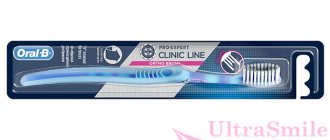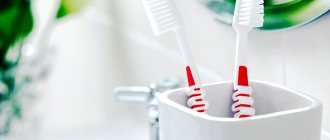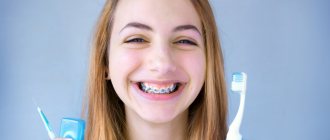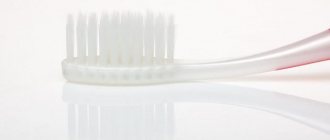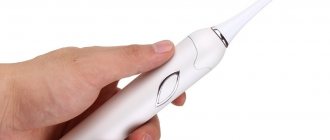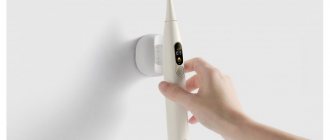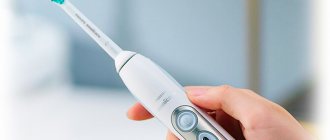implies compliance with several important rules.
- “You should brush your teeth after every meal.” I will say right away that this is basically impossible in real life. As an experienced person who has had braces for more than two years, I advise you to brush your teeth no more than three times a day. Firstly, it’s easier to maintain mental calm, and secondly, toothpaste irritates and dries the mucous membranes and skin it comes into contact with, and too frequent and long contact with toothpaste is also not very desirable.
- “If you brushed your teeth for less than 10 minutes, consider that you didn’t brush at all.” This is 100%!
- Be sure to clean the spaces under the arches with brushes if you don’t want to treat caries in each tooth later!
General rules for caring for braces
If you want to maintain healthy teeth, you must follow the general rules for caring for braces. Let's describe them briefly:
- For braces, special toothbrushes are used that allow you to clean the enamel and all elements of the orthodontic structure.
- Treatment of the oral cavity should be performed 4-5 times a day or more often (after all meals, as well as in the morning and evening).
- It is necessary to clean not only the teeth themselves, but also all accessible surfaces of the braces.
- It is advisable to buy toothpaste with a high content of fluoride and calcium to increase the protective properties of the enamel. For the paste to be effective, it is recommended to regularly change it to a product from another company, since the enamel gets used to a certain composition and stops reacting to it.
- If you cannot clean some places, you should resort to the help of additional devices: dental floss, special brushes, etc.
- If you use rinse aid, do not use regular brands, but only ones that do not contain alcohol or dyes.
The main task of caring for the oral cavity while wearing braces is to preserve the enamel. This can be done in different ways. Read for interest what scientists are offering today: Scientists have found a way to protect tooth enamel in cancer patients.
Can I use an electric toothbrush?
Some patients clean them with an electric toothbrush after getting braces. There is a myth that this should not be done, because electric brushes can damage structural parts, as a result of which it will have to be replaced.
Dentists refute this opinion and say that brushing your teeth with an electric brush is acceptable. The main thing is to choose the right model, which is equipped with orthodontic attachments, and follow the doctor’s recommendations.
The use of electric toothbrushes in caring for braces is even preferable for a number of reasons. Such brushes remove plaque better because they automatically perform tens of times more cleaning movements than we can do with our hands.
Modern sonic and ultrasonic models clean not only through mechanical action, but also using sound waves and pulsations. Using electric brushes, you can remove plaque and dirt from under the gums, from between teeth and other hard-to-reach areas.
What types of braces cleaning products are there?
Modern specialized stores offer a large selection of all kinds of products for cleaning braces. Among them:
- Brush for braces
In practice, orthodontists use several types of toothbrushes for braces. The first type is an orthodontic brush, which has a small head (about 3 cm) and V-shaped bristles. Thanks to these design features, it easily penetrates between the arc and the groove and cleans out plaque. The second type is a brush for braces with a mono-beam structure. It can also be used to clean narrow areas between braces and the teeth themselves. Sometimes an electric brush is distinguished as one of the types of orthodontic means for cleaning braces. But in practice, it is also used by those who do not wear braces.
- Oral irrigator
An irrigator is a device with a container for water or an antiseptic solution, which is supplied through a nozzle under pressure into the oral cavity. Thanks to its gentle effect, the water jet cleans the most remote areas of the oral cavity and, at the same time, does not damage soft tissues and parts of the braces system, in particular. Manufacturers of irrigators claim that with the help of such an innovative device, teeth cleaning at home can be made almost identical to that at the dentist. In addition, with the help of an irrigator you can remove about 70% of plaque, which is twice as much as with a regular brush.
- Rinse aid
The rinse is used after the teeth and braces have been brushed. It helps maintain the normal condition of the mucous membranes of the cheeks and gums, and also prevents the development of pathogenic microflora, thanks to its disinfecting ability.
- Brush for braces
Orthodontic brush for braces: features of choice
When choosing an orthodontic brush for cleaning braces, you should pay attention to the following points:
- Dimensions of the cleaning head - its length should not exceed 3 cm (or the width of three teeth) so that the brush can penetrate into the most difficult to reach places. At the same time, it should not be too small.
- The material from which the bristles of the brush are made is better synthetic than natural. Natural pile is a more favorable environment for the proliferation of pathogenic microorganisms; in addition, it is subject to rapid wear.
- When choosing the hardness of the brush, you should give preference to the bristles marking - “soft” or “medium hardness”.
- A new toothbrush should be purchased approximately once every three months or as the need arises (loss of shape, wear of bristles, etc.).
Today, the most popular on the market are specialized brushes for Oral Bi and Curapro braces.
Dental floss is used to clean between teeth. Flosses can be waxed or unwaxed. Flosses are usually scented and impregnated with special wax, which helps glide and effectively removes interdental plaque. Orthodontic patients are recommended to use a special dental floss - super-floss. This thread has different thicknesses and is heterogeneous in structure; it has a stiffer tip, which is convenient to insert under the arch of the bracket system.
Apply a small amount of toothpaste to a dry toothbrush. Positioning the brush at an angle, carefully clean the problematic space between the braces and the gum. A mono-tuft brush and a dental brush are also used for these areas. Using circular vibrating movements, clean each tooth for at least 10 seconds, carefully removing plaque around the bracket. Remember, a dental brush is more effective at removing food debris around the bracket and under the orthodontic archwire. Brush your teeth slowly, upper and lower teeth separately, each tooth from the outside and inside. Brush the teeth of the lower jaw from bottom to top, and teeth of the upper jaw from top to bottom. Additionally The gums are massaged, the palate and back of the tongue are cleaned. Teeth are brushed in the morning, in the evening and, preferably, after each meal. Without good oral hygiene habits, normal brushing can cause gums to bleed. If a regular toothbrush is used incorrectly, rough movements along the gum line can cause serious injury. Modern electric toothbrushes are true works of art. Clinical trials confirm that they provide significant benefits and better plaque removal while remaining gentle on teeth and gums. The basic rules of use are similar to those stated above. Unlike a mechanical brush, 5 seconds are enough to completely clean each tooth.
Fdoss is used to clean interdental spaces. Flosses can be waxed or unwaxed. Flosses are usually scented and impregnated with special wax, which helps glide and effectively removes interdental plaque.
Is an electric brush enough?
Even the most modern and high-quality toothbrush is not enough to fully care for the oral cavity of a person who wears braces. To maintain dental health, comprehensive hygiene is important, which, in addition to brushing with special toothbrushes, includes the use of superfloss, irrigator and mouth rinses:
- Superfloss is a dental floss specially designed for orthodontic patients. It is more convenient to insert it into the interdental spaces compared to regular floss, and it also allows you to efficiently clean the surface of the tooth around the lock.
- Every person who wears dental appliances needs an irrigator. This device improves the quality of oral hygiene several times and reduces the risk of caries and other diseases. The irrigator directs a powerful stream of water, which removes dirt and plaque from under the edge of the gum, from interdental spaces and other areas that could not be cleaned by other means.
- Rinse aid. This product not only washes away the remaining plaque and dirt, but also has an antiseptic and anti-inflammatory effect. You should choose a mouthwash as prescribed by your doctor.
How to choose a good brush
Products for the care of braces are distinguished by a special arrangement of villi, which allows them to penetrate even the most inaccessible places between the brackets and the surface of the teeth and clean out food particles and hard plaque without any problems. The brush also has a convenient shape and is easy to hold in your hands.
Important Requirements
First of all, the brush for braces must be made of hypoallergenic synthetic material, they must be soft and meet the following requirements:
- Convenient and small size.
- Hygiene.
- Safety.
Just like regular toothbrushes, this too needs to be replaced with new ones periodically. This should be done at least once every two months, but do not wait until the bristles lose their shape.
How to care for her?
In order for such an important device to serve you for many years, helping to clean the oral cavity efficiently and effectively, pay attention to the tips below:
- Nozzles are subject to periodic treatment with an antiseptic and replacement.
It is necessary to constantly rinse brushes/nozzles with running water before/after hygiene procedures. Leftover food left on the villi can cause the spread of bacteria and microorganisms. - The device should be stored in an upright position, the brushes should be stored in empty, dry glasses or stands.
- The nozzles are subject to periodic treatment with an antiseptic (once a week) and replacement (every three to four months).
- After hygiene procedures, check the charge level of the brush to avoid draining the battery.
How to properly brush teeth with braces - basic methods
There are several methods. Each of them has its own disadvantages and advantages. Some techniques can be combined to achieve better cleansing. Only your dentist can recommend which toothpaste to use to brush your teeth with braces installed. Pastes that strengthen tooth enamel with a high fluoride content are often used.
Orthodontic toothbrush (V-shape)
A toothbrush specially designed for braces (mono-tuft toothbrush) has a depression in the center, hence the name V-shaped. Suitable for cleaning all surfaces of teeth, capable of capturing most of the orthodontic apparatus. It is better to purchase a design with soft bristles so as not to injure your gums. Since you need to brush your teeth several times a day, you need to remember to change it periodically.
Mono-tuft toothbrush
A special small brush with one tuft, which is suitable for treating distant teeth and the front surface of locks. With its help you can reach hard-to-reach places. Each tooth is cleaned separately and thoroughly. Changes monthly. There are no special recommendations for using a mono-tuft brush, just clean carefully, do not press too hard.
Orthodontic brush
For daily dental care with braces, it is recommended to use special brushes. They are suitable for cleaning the tooth surface under the arches, where brushes cannot reach. An important rule for cleaning braces with a brush is caution. Do not tug the arc too hard so as not to damage its fixation. It’s better to take not just one brush, but a whole set. They need to be changed monthly, and sometimes more often. Not the most convenient way, but very effective. You can see an example of working with a brush in the video below.
Dental floss
Dental floss is perfect for cleaning braces during the appointment period. The classic one is not suitable for patients. Since it is inconvenient to brush teeth with braces with regular-tipped floss, you need to take a special thread with a hard tip - superfloss. This design allows you to easily pass it under the parts of the bracket system. With its help, they get rid of food debris between the teeth and around the locks. It is not recommended to make excessively fast movements or forceful pressure, so as not to injure the gums.
Irrigator
An irrigator is a very effective device for daily cleaning of teeth with braces. It is similar to an electric toothbrush, but instead of bristles it has a special attachment through which a strong stream of water is supplied.
Bristles stiffness
The bristles are the most expensive part of a toothbrush and determine how thoroughly and effectively you clean. In the production of modern brushes, artificial bristles are used, which will not only last longer, but will also not become a habitat for bacteria and microorganisms.
According to the stiffness of the bristles, brushes are:
- soft and ultra-soft;
- medium hardness;
- tough.
Do not choose a hard brush yourself - it may not fit and damage the enamel and gums. These brushes are suitable for caring for some removable dentures.
Most people are comfortable with soft or ultra-soft
brushes
with a lot of bristles. If you like coffee and smoke, choose a brush with medium hardness. The main thing is to remember that it is easier to damage enamel than it seems.
Why additional equipment is needed
It is after the braces have been installed that areas appear on the teeth that are simply impossible to clean with an ordinary toothbrush, because it cannot even reach those places. If action is not taken in time, food that is retained will form harmful bacteria in the oral cavity. An ordinary brush can even cause harm, because both the tooth pulp and the gums are very vulnerable when wearing braces.
It must be remembered that hygiene is the most important thing in the prevention of many diseases that arise in the oral cavity. From this it turns out that it is necessary to carry out ideal teeth cleaning.
Review of the best orthodontic brush models
You may be confused by the huge selection of orthodontic toothbrushes, so we will help you make your choice by presenting a brief overview of the most popular models:
- Vitis Orthodontic has a V-shaped bristle, as well as a special reinforced projection consisting of elongated bristles - for improved cleaning quality. The bristles themselves have varying degrees of hardness, so they can be used to combine types of care - cleansing and gentle gum care. This line features brushes of different sizes, so you can choose a model for each family member, including children. The cost is approximately 250 rubles.
- Miradent I-Prox is a mono-beam brush. The system allows you to change attachments and store them in a special compartment in the brush handle. Thanks to its special pointed shape, the brush effectively allows you to clean the most inaccessible places and interdental spaces, and cleans your teeth from two different angles. This brush will cost you about 370 rubles.
- Oral-B Electric Brush. This does not mean the brush itself, but a set of three replaceable attachments for it - OD-17. Thanks to the fastening system, they fit all Oral-B electric brushes and are designed specifically for cleaning braces. The cost of the set is approximately 700 rubles.
- Panasonic EW-DS 11 K 520 is also an electric brush. It has a rectangular head and bristles made from a material specially designed for effective cleaning. Unlike the previous system, Panasonic makes not circular, but pulsating movements at great speed, which is preferable for the design of the system. The cost of the device is more than 1000 rubles.
vote
Article rating
Comparison table of characteristics
For a quick analysis of the presented products, the main characteristics are collected in a table:
| The product's name | Nozzle shape | Compatible with electric toothbrushes |
| Sensi Ultrathin | Round petal-shaped | Oral-B Genius, Pro, Smart and Vitality |
| CrossAction | Round | Triumph, Smart, PRO, Vitality, Genius |
| 3D White | Round with rubberized bowl | All except Pulsonic |
| Precision Clea | Round in the center with a recess | All except Pulsonic |
| Sensitive | Round | All |
| TriZone | Elongated, oval | All except Pulsonic/Sonic |
| Stages Kids Cars | Round | Stages Power |
| Stages Kids Princess | Round with bristles of different lengths | Stages Power |
| Stages Kids Avengers | Round | Stages Power |
| Stages Kids Frozen | Round | Oral-B Stages Power |
When choosing a new head for your Oral-B electric toothbrush, you should consider the impact and desired effect, as well as the level of stiffness of the bristles. All attachments with reciprocating technology are suitable for any brushes of this brand (except for one series). And this top with pros and cons, customer reviews and recommendations from professionals will help you make the right choice.
